Research Progress on Ecological Carrying Capacity and Ecological Security, and Its Inspiration on the Forest Ecosystem in the Karst Desertification Control
Abstract
:1. Introduction
2. Materials and Methods
3. Results
3.1. Annual Distribution of the Literature
3.2. Regional and Institutional Distribution of the Literature
3.3. Distribution of Research Topics in the Literature
3.4. Main Research Stage Division
3.5. Main Research Developments and Landmark Achievements
3.5.1. Forest Ecosystems
- (1)
- Forest restoration has different effects on ecosystem services and ECC.
- (2)
- Forest ecosystems exhibit a high level of connectivity among patches in various source areas.
3.5.2. Assessment of Forest ECC
- (1)
- The comprehensive evaluation model is a standard demonstration of the small-scale forest ECC evaluation model.
- (2)
- The evaluation of forest ECC depends on ecosystem supply and human demand.
3.5.3. Regulation of Forest ECC
- (1)
- Forest structure optimization and functional enhancement are the main means of regulating ECC.
- (2)
- The adjustment of forest industry structure and strengthening forest management are important regulatory measures for ECC.
3.5.4. Enhancement of Forest ES
- (1)
- Constructing an ES pattern is an important strategy for enhancing the external ES of forests.
- (2)
- The ES early-warning system plays a protective role in enhancing ES.
4. Discussion
4.1. Distribution Differences in the Study Area
4.2. Key Scientific Issues to Be Solved and Prospects
4.2.1. Forest Ecosystems
- (1)
- In response to the key scientific issue of unclear mechanisms affecting the supply capacity of forest ecosystems under complex and variable soil types and moisture conditions, research should be conducted on the internal mechanisms of how the soil–vegetation–atmosphere system responds to and adapts to drought stress.
- (2)
- In response to the key scientific issues regarding the differential mechanisms of ECC in different forest ecosystems, restoration models should be clarified, including the uniqueness of vegetation species’ composition, differences in functional group classification, and the operational mechanisms that dominate ecological processes under each model.
4.2.2. Assessment of Forest ECC
- (1)
- In response to the key scientific issue of an incomplete ECC evaluation system, it is necessary to deepen the simulation and prediction research on evolutionary trends and future scenarios, and construct a universal and scientific evaluation system.
- (2)
- In response to the key scientific issue of the differential mechanisms of forest ECC at different research scales, it is essential to clarify the intricate patterns of interaction and feedback mechanisms involving multiple factors that influence forest ECC at different scales of research.
4.2.3. Regulation of Forest ECC
- (1)
- In response to the key scientific issue of balancing and coordinating socio-economic development with forest ECC in KD areas, researchers should prioritize understanding the complex and subtle interaction between the socio-economic development process and ECC.
- (2)
- In response to the key scientific issue of how land use patterns serve as a key driving force affecting forest ECC, it is essential to investigate the effects of various land use patterns on vegetation structure and function, and the ecosystem services they deliver.
4.2.4. Enhancement of Forest ES
- (1)
- In response to the key scientific issue concerning the increase in the forest ES threshold under drought stress intensity, researchers should focus on understanding the complex and nonlinear interaction between drought stress intensity and forest ES. It is important to accurately identify the critical turning points in this relationship.
- (2)
- In response to the critical scientific question of elevating forest ES thresholds across varying levels of soil erosion, it is imperative to delve into the intricate and nuanced relationships and feedback loops between soil erosion and vegetation development.
5. Conclusions
Author Contributions
Funding
Data Availability Statement
Acknowledgments
Conflicts of Interest
References
- Meli, P.; Schweizer, D.; Winowiecki, L.A.; Chomba, S.; Aynekulu, E.; Guariguata, M.R. Mapping the Information Landscape of the United Nations Decade on Ecosystem Restoration Strategy. Restor. Ecol. 2023, 31, e13810. [Google Scholar] [CrossRef]
- Cohen, J. Population Growth and Earth’s Human Carrying Capacity. Science 1995, 269, 341–346. [Google Scholar] [CrossRef] [PubMed]
- Zhang, Y.F. On Programme of Action for Comprehensively Promoting the Construction of a Beautiful China. J. Nanjing Tech. Univ. (Soc. Sci. Ed.) 2024, 23, 1–11+109. [Google Scholar]
- Yang, Z.F.; Sui, X. Assessment of the ecological carrying capacity based on the ecosystem health. Acta Sci. Circumstantiae 2005, 5, 586–594. [Google Scholar] [CrossRef]
- Feng, Z.M.; Yang, Y.Z.; Yan, H.M.; Pan, T.; Li, P. A review of resources and environment carrying capacity research since the 20th Century: From theory to practice. Resour. Sci. 2017, 39, 379–395. [Google Scholar] [CrossRef]
- Fan, J.; Wang, Y.F.; Tang, Q.; Zhou, K. Academic Thought and Technical Progress of Monitoring and Early-warning of the National Resources and Environment Carrying Capacity (V 2014). Sci. Geogr. Sin. 2015, 35, 1–10. [Google Scholar] [CrossRef]
- Ying, L.X.; Kong, L.Q.; Xiao, Y.; Yang, Z.Y. The research progress and prospect of ecological security and its assessing approaches. Acta Ecol. Sin. 2022, 42, 1679–1692. [Google Scholar]
- Crutzen, P.J. Geology of Mankind. Nature 2002, 415, 23. [Google Scholar] [CrossRef]
- Waters, C.N.; Zalasiewicz, J.; Summerhayes, C.; Barnosky, A.D.; Poirier, C.; Gałuszka, A.; Cearreta, A.; Edgeworth, M.; Ellis, E.C.; Ellis, M.; et al. The Anthropocene Is Functionally and Stratigraphically Distinct from the Holocene. Science 2016, 351, aad2622. [Google Scholar] [CrossRef]
- Myers, N. The Environmental Dimension to Security Issues. Environmentalist 1986, 6, 251–257. [Google Scholar] [CrossRef]
- Anspaugh, L.; Catlin, R.; Goldman, M. The Global Impact of the Chernobyl Reactor Accident. Science 1988, 242, 1513–1519. [Google Scholar] [CrossRef] [PubMed]
- Käppeli, O.; Auberson, L. The Science and Intricacy of Environmental Safety Evaluations. Trends Biotechnol. 1997, 15, 342–349. [Google Scholar] [CrossRef] [PubMed]
- Hertel, T.W.; Baldos, U.L.C. Attaining Food and Environmental Security in an Era of Globalization. Glob. Environ. Change-Hum. Policy Dimens. 2016, 41, 195–205. [Google Scholar] [CrossRef]
- Ofipcc, W.G.I. Climate Change 2013: The Physical Science Basis. Contrib. Work. 2013, 43, 866–871. [Google Scholar] [CrossRef]
- Costanza, R.; De Groot, R.; Sutton, P.; Van Der Ploeg, S.; Anderson, S.J.; Kubiszewski, I.; Farber, S.; Turner, R.K. Changes in the Global Value of Ecosystem Services. Glob. Environ. Chang. 2014, 26, 152–158. [Google Scholar] [CrossRef]
- Borrelli, P.; Robinson, D.A.; Panagos, P.; Lugato, E.; Yang, J.E.; Alewell, C.; Wuepper, D.; Montanarella, L.; Ballabio, C. Land Use and Climate Change Impacts on Global Soil Erosion by Water (2015–2070). Proc. Natl. Acad. Sci. USA 2020, 117, 21994–22001. [Google Scholar] [CrossRef] [PubMed]
- Xiong, K.N.; Li, P.; Zhou, Z.F.; Lv, T.; Lan, A.J. The Typical Study on RS-GIS of Karst Desertification—With a Special Reference to Guizhou Province; Geology Press: Beijing, China, 2002. [Google Scholar]
- Xu, S.X.; Zhao, X.Q.; Sun, P.; Zhao, W.; Zhao, T.B. A serious menace to biological resources: Losses of biodiversity. Resour. Sci. 2002, 2, 6–11. [Google Scholar]
- Yang, M.D. On the fragility of karst environment. Yunnan Geogr. Environ. Res. 1990, 1, 21–29. [Google Scholar]
- Zhang, Y.; Zhang, Z.H.; Zhang, M.S.; Yuan, Z.W. The Global Situation of Karst Desertification Research Based on Forest Ecology. Forests 2024, 15, 126. [Google Scholar] [CrossRef]
- Yuan, D.X. Karst in southwest China and its comparison with karst in north China. Quat. Sci. 1992, 4, 352–361. [Google Scholar]
- Zhang, S.H.; Xiong, K.N.; Min, X.Y.; Zhang, S. Demographic Shrinkage Promotes Ecosystem Services Supply Capacity in the Karst Desertification Control. Sci. Total Environ. 2024, 917, 170427. [Google Scholar] [CrossRef] [PubMed]
- Xiong, K.N.; Li, J.; Long, M.Z. Features of Soil and Water Loss and Key Issues in Demonstration Areas for Combating Karst Rocky Desertification. Acta Geogr. Sin. 2012, 67, 878–888. [Google Scholar]
- Zhang, Y.; Xiong, K.N.; Yu, Y.H.; Tan, D.J.; Cheng, W.; Xu, M. Research on Key Technology of Vegetation Restoration and Forest Industry Development in Karst Rocky Desertification Environment. J. Agric. Sci. Technol. 2018, 20, 19–25. [Google Scholar] [CrossRef]
- Guo, Y.L.; Ma, X.M.; Zhu, Y.L.; Chen, D.H.; Zhang, H. Research on Driving Factors of Forest Ecological Security: Evidence from 12 Provincial Administrative Regions in Western China. Sustainability 2023, 15, 5505. [Google Scholar] [CrossRef]
- Convertino, M.; Baker, K.M.; Vogel, J.T.; Lu, C.; Suedel, B.; Linkov, I. Multi-Criteria Decision Analysis to Select Metrics for Design and Monitoring of Sustainable Ecosystem Restorations. Ecol. Indic. 2013, 26, 76–86. [Google Scholar] [CrossRef]
- Ye, X.; Kang, S.Z.; Zhao, Y.H.; Han, L.; Xiang, X.M.; Li, F. Spatio-temporal relationship between vegetation restoration and ecosystem services in the Loess Plateau of Northern Shaanxi, China. Chin. J. Appl. Ecol. 2022, 33, 2760–2768. [Google Scholar] [CrossRef]
- Liu, F.Q.; Liu, J.; Yao, X.J.; Zhang, Y.L.; Yuan, S.J. Mechanical factors influencing soil-reinforcement by roots and identifying appropriate plant species for erosion control. Acta Ecol. Sin. 2015, 35, 6306–6315. [Google Scholar] [CrossRef]
- Li, M.Y.; Zhou, P.; Deng, L. Spatial distribution of carbon storages in the terrestrial ecosystems and its influencing factors on the Loess Plateau. Acta Ecol. Sin. 2021, 41, 6786–6799. [Google Scholar]
- Jian, Y.Q.; Dai, Y.; Huang, Z.B.; Zhan, A.S.; Li, H.C.; Wang, Z.F. Identification of key points and differentiation planning strategies of Shantou, Guangdong, China. Chin. J. Appl. Ecol. 2023, 34, 2730–2738. [Google Scholar] [CrossRef]
- Shi, Y.; Zeng, Y.; Guo, J.; Fang, N. Effect of the New Phase of the Grain for Green Program on Grain Output on the Loess Plateau. Res. Soil Water Conserv. 2022, 29, 419–425. [Google Scholar] [CrossRef]
- Feng, X.M.; Fu, B.J.; Piao, S.L.; Wang, S.; Ciais, P.; Zeng, Z.; Lu, Y.; Zeng, Y.; Li, Y.; Jiang, X.; et al. Revegetation in China’s Loess Plateau Is Approaching Sustainable Water Resource Limits. Nat. Clim. Chang. 2016, 6, 1019–1022. [Google Scholar] [CrossRef]
- Chen, X.; Zhang, Y.L.; Ye, C.; Wang, Y.; Zhang, Q.F. Land use and ecologIcal planning of the lanlingxi watershed in the three gorges reservoir, china. Resour. Environ. Yangtze Basin 2010, 19, 147–154. [Google Scholar]
- Chi, Y.K.; Xiong, K.N.; Zhang, Y.; Dong, Y.P.; Liu, C.M.; Xu, L.X. The beneficial results, problems and suggestions of grass—Planting and livestock—Raising to bring rocky desertification under control in the Karst areas of southwest China. Heilongjiang Anim. Sci. Vet. Med. 2015, 11, 143–147. [Google Scholar] [CrossRef]
- Lasanta, T.; Nadal-Romero, E.; Errea, P.; Arnaez, J. The Effect of Landscape Conservation Measures in Changing Landscape Patterns: A Case Study in Mediterranean Mountains. Land Degrad. Dev. 2016, 27, 373–386. [Google Scholar] [CrossRef]
- Zhang, Z.F.; Xiong, K.N.; Zhang, Y.; Ning, Y.Z. Research Progress on Forest Eco-Product Value Realization and Eco-Industry: The Inspiration for Planted Forests in Karst Desertification Control. Forests 2024, 15, 517. [Google Scholar] [CrossRef]
- Lu, S.S.; Qin, F.; Chen, N.; Yu, Z.Y.; Xiao, Y.M.; Cheng, X.Q.; Guan, X.D. Spatiotemporal Differences in Forest Ecological Security Warning Values in Beijing: Using an Integrated Evaluation Index System and System Dynamics Model. Ecol. Indic. 2019, 104, 549–558. [Google Scholar] [CrossRef]
- Tu, Y.; Liu, M.; Gao, C.C.; Sun, Y.W.; Cai, C.L.; Su, L. Construction of ecological sources identification system for metropolitan areas and diagnosis of key areas for ecological restoration in nationally spatial areas. Acta Ecol. Sin. 2022, 42, 7056–7067. [Google Scholar] [CrossRef]
- Liu, Y.Q.; Wang, J.L.; Li, Z.Z. Research Process on the Effects of Straw Mulch on Soil Moisture and Soil Erosion. Res. Soil Water Conserv. 2021, 28, 429–436. [Google Scholar] [CrossRef]
- Wang, X.M.; Zhao, P.; Long, Y.X.; Song, W.W.; Liu, X.C. Identification of key areas of land space ecological protection and restoration based on the pattern of ecological security in Guangdong, Hong Kong and Macau. Acta Ecol. Sin. 2022, 42, 450–461. [Google Scholar]
- Lieth, H.; Whittaker, R.H. (Eds.) Primary Productivity of the Biosphere; Ecological Studies; Springer: Berlin/Heidelberg, Germany, 1975; Volume 14, ISBN 978-3-642-80915-6. [Google Scholar]
- Wang, J.J.; Yao, X.H.; Li, J.R.; Chang, H.; Wang, Y.G. Assessment for Ecological Carrying Capacity of Heihe River Basin. Res. Environ. Sci. 2000, 2, 44–48. [Google Scholar] [CrossRef]
- Rees, W.E. Ecological Footprints and Appropriated Carrying Capacity: What Urban Economics Leaves Out. Environ. Urban. 1992, 4, 121–130. [Google Scholar] [CrossRef]
- Yue, D.X. RS & GIS-Based Spatial Analysis on Ecological Carrying Capacity Pattern of Northwest China: Does Supply Meet Demand? Quat. Int. 2012, 279–280, 551. [Google Scholar] [CrossRef]
- Gao, J.X.; Chen, S.B. Optimize the Spacial Structure Based on Ecological Capacity. Environ. Prot. 2014, 42, 12–18. [Google Scholar] [CrossRef]
- Wackernagel, M.; Monfreda, C.; Schulz, N.B.; Erb, K.H.; Haberl, H.; Krausmann, F. Calculating National and Global Ecological Footprint Time Series: Resolving Conceptual Challenges. Land Use Policy 2004, 21, 271–278. [Google Scholar] [CrossRef]
- Zhang, S.S.; Zhang, L.; Chen, T.; Dong, Y.W.; Zhu, X.D.; Qi, L.Y. Spatial variation and optimization of ecological carrying capacity in Jiangsu coastal area, China. Chin. J. Appl. Ecol. 2021, 32, 2158–2168. [Google Scholar] [CrossRef]
- Wackernagel, M.; Onisto, L.; Bello, P.; Linares, A.C.; Falfán, I.S.; García, J.M.; Guerrero, A.I.; Guerrero, M.G. National Natural Capital Accounting with the Ecological Footprint Concept. Ecol. Econ. 1999, 29, 375–390. [Google Scholar] [CrossRef]
- Chen, X.P.; Liu, Q.Y.; Fang, K.; He, J.J.; Chen, Y.; Wang, T.T.; Fang, C.L.; Shen, Y. Tracking National Sustainability of Critical Natural Capital and the Socioeconomic Drivers in the Context of the Belt and Road Initiative. Ecol. Indic. 2020, 114, 106315. [Google Scholar] [CrossRef]
- Zhu, H.; Cheng, F.; Wang, J.J.; Jiao, Y.M.; Zhou, J.C.; Sha, J.; Liu, F.; Nong, L. Variation in the Ecological Carrying Capacity and Its Driving Factors of the Five Lake Basins in Central Yunnan Plateau, China. Sustainability 2023, 15, 14442. [Google Scholar] [CrossRef]
- Xu, W.H.; Yang, Y.Y.; Zhang, L.; Xiao, Y.; Wang, X.K.; Yang, Z.Y. Evaluation methods and case study of regional ecological carrying capacity for early-warning. Prog. Geogr. 2017, 36, 306–312. [Google Scholar] [CrossRef]
- Sun, Z.X.; Zhao, B.H.; Qin, A.C.; Zhu, K.X. Evaluation of Sustainable Development of Rural Tourism in Ecologically Fragile Areas and Analysis of Influencing Factors: Taking Dongchuan District of Kunming as an Example. Ecol. Econ. 2022, 38, 157–163+170. [Google Scholar]
- Inostroza, L.; Barrera, F.D.L. Ecosystem Services and Urbanisation. A Spatially Explicit Assessment in Upper Silesia, Central Europe. IOP Conf. Ser. Mater. Sci. Eng. 2019, 471, 092028. [Google Scholar] [CrossRef]
- Jin, Y.; Lu, Z.H.; Tan, F.F.; Zhang, M.; Zhang, H.Y. Assessment of ecological carrying capacity on the typical resources-based cities: A case study of Tangshan City. Acta Ecol. Sin. 2015, 35, 4852–4859. [Google Scholar] [CrossRef]
- He, Y.F.; Xie, H.L. Exploring the Spatiotemporal Changes of Ecological Carrying Capacity for Regional Sustainable Development Based on GIS: A Case Study of Nanchang City. Technol. Forecast. Soc. Chang. 2019, 148, 119720.1–119720.9. [Google Scholar] [CrossRef]
- Jing, Y.Q.; Zhang, F.; Chen, L.H.; Zhang, Y.; Wang, X.P.; Li, Z.; KUNG, H. Investigation on eco-environmental effects of land use/cover-landscape pattern and climate change in Ebinur Lake Wetland Nature Reserve. Acta Sci. Circumstantiae 2017, 37, 3590–3601. [Google Scholar] [CrossRef]
- Wang, H.F.; Rao, E.; Xiao, Y.; Yan, Y.; Lu, H.T.; Zhu, J.Y. Ecological risk assessment in Southwest China based on multiple risk sources. Acta Ecol. Sin. 2018, 38, 8992–9000. [Google Scholar] [CrossRef]
- Xiao, J.; Xiong, K.N. A Review of Agroforestry Ecosystem Services and Its Enlightenment on the Ecosystem Improvement of Rocky Desertification Control. Sci. Total Environ. 2022, 852, 158538. [Google Scholar] [CrossRef]
- Fang, Q.S.; Li, H.X. The Concept Delimitation, the Value Realization Process, and the Realization Path of the Capitalization of Forest Ecological Resources. Nat. Resour. Forum 2021, 45, 424–440. [Google Scholar] [CrossRef]
- Hao, T.X.; Wang, B.; Niu, X.; Liu, S.R.; Yu, G.R. Practice and Thinking of Comprehensively Improving the Quality and Stability of Forest Ecosystem in China. Terr. Ecosyst. Conserv. 2022, 2, 13–31. [Google Scholar] [CrossRef]
- Eriksson, A.; Eggers, J.; Claesson, S.; Fridman, J.; Nylander, M.; Olsson, P.; Ohman, K.; Nordstrom, E.-M. Availability and Mobilization of Forest Resources in Sweden. Eur. J. For. Res. 2024, 143, 703–712. [Google Scholar] [CrossRef]
- Gao, M.W.; Hu, Y.C.; Li, X.; Song, R. Construction of ecological security pattern based on the importance of ecosystem services and environmental sensitivity in karst mountainous areas: A case study in Hechi, Guangxi. Acta Ecol. Sin. 2021, 41, 2596–2608. [Google Scholar] [CrossRef]
- Li, Z.; Ding, Y.; Wang, Y.L.; Chen, J.; Wu, F.M. Construction of Ecological Security Pattern in Mountain Rocky Desertification Area Based on MCR Model: A Case Study of Nanchuan, Chongqing. J. Ecol. Rural Environ. 2020, 36, 1046–1054. [Google Scholar] [CrossRef]
- Ojeda Luna, T.; Zhunusova, E.; Günter, S.; Dieter, M. Measuring Forest and Agricultural Income in the Ecuadorian Lowland Rainforest Frontiers: Do Deforestation and Conservation Strategies Matter? For. Policy Econ. 2020, 111, 102034. [Google Scholar] [CrossRef]
- Zhu, Y.L.; Li, M.J.; Gu, R.H. Security prewarning and regulation of ecological carrying capacity of zhang-zhu-tan urban agglomeration based on press-state-response model. Resour. Environ. Yangtze Basin 2017, 26, 2057–2064. [Google Scholar]
- Wang, G. Ecological Sustainability Evaluation of Henan Province Based on the Improved Ecological Footprint Method. J. Zhongzhou Univ. 2013, 30, 21–24. [Google Scholar]
- Song, Q.F.; Niu, X.; Wang, B. Review on forest ecosystem services assessment based on big data. Chin. J. Ecol. 2015, 34, 2914–2921. [Google Scholar] [CrossRef]
- Qin, X.L.; Chen, X.Z.; Zhong, X.Q.; Zu, X.F.; Sun, G.F.; Ying, L.Y. Development of Forest Fire Early Warning and Monitoring Technique System in China. For. Grassl. Resour. Res. 2015, 6, 45–48. [Google Scholar] [CrossRef]
- Boukherroub, T.; LeBel, L.; Ruiz, A. A Framework for Sustainable Forest Resource Allocation: A Canadian Case Study. Omega-Int. J. Manag. Sci. 2017, 66, 224–235. [Google Scholar] [CrossRef]
- Guo, B.; Jiang, L.; Luo, W.; Yang, G.; Ge, D.Z. Study of an evaluation method of ecosystem vulnerability based on remote sensing in a southwestern karst mountain area under extreme climatic conditions. Acta Ecol. Sin. 2017, 37, 7219–7231. [Google Scholar] [CrossRef]
- Farooq, T.H.; Shakoor, A.; Wu, X.; Li, Y.; Rashid, M.H.U.; Zhang, X.; Gilani, M.M.; Kumar, U.; Chen, X.; Yan, W. Perspectives of Plantation Forests in the Sustainable Forest Development of China. iForest 2021, 14, 166–174. [Google Scholar] [CrossRef]
- Li, X.R.; Zhang, Z.H.; Tan, H.J.; Gao, Y.H.; Liu, L.C.; Wang, X.P. Ecological Restoration and Recovery in the Wind-Blown Sand Hazard Areas of Northern China: Relationship between Soil Water and Carrying Capacity for Vegetation in the Tengger Desert. Sci. China Life Sci. 2014, 5, 539–548. [Google Scholar] [CrossRef]
- Khlosi, M.; Cornelis, W.M.; Douaik, A.; Hazzouri, A.; Habib, H.; Gabriels, D. Exploration of the Interaction between Hydraulic and Physicochemical Properties of Syrian Soils. Vadose Zone J. 2013, 12, 1–11. [Google Scholar] [CrossRef]
- Sun, M.; Li, P.; Ren, P.X.; Tang, J.Y.; Zhang, C.C.; Zhou, X.L.; Peng, C.H. Divergent response of vegetation phenology to extreme temperatures and precipitation of different intensities on the Tibetan Plateau. Sci. China Earth Sci. 2023, 53, 2231–2242. [Google Scholar] [CrossRef]
- Fu, B.J.; Tian, H.Q.; Tao, F.L.; Zhao, W.W.; Wang, S. Progress of the Impact of Global Change on Ecosystem Services. China Basic Sci. 2020, 22, 25–30. [Google Scholar] [CrossRef]
- Zhang, L.; Lu, N.; Cheng, L.H. Regime shifts and early warning signals in dryland ecosystems-an identification method based on landscape pattern characteristics. Acta Ecol. Sin. 2023, 43, 6486–6498. [Google Scholar]
- Kou, M.; Jiao, J.Y. Changes in Vegetation and Soil Properties across 12 Years after Afforestation in the Hilly-Gully Region of the Loess Plateau. Glob. Ecol. Conserv. 2022, 33, e01989. [Google Scholar] [CrossRef]
- Tian, Y.; Xu, Z.; Wang, Y.L.; He, J.L.; Wang, Z.J. Soil quality evaluation for different forest plantation of sandy land in Yinchuan Plain, Ningxia. Acta Ecol. Sin. 2023, 43, 1515–1525. [Google Scholar] [CrossRef]
- Chen, S.F.; Cha, X.; Li, X.Y. Ecological Restoration Research of Red Soil Degradation Based on Ecological Footprint Model. Res. Soil Water Conserv. 2008, 5, 136–139. [Google Scholar]
- Song, S.Z.; Xiong, K.N.; Chi, Y.K. Ecological Stoichiometric Characteristics of Plant-Soil-Microorganism of Grassland Ecosystems under Different Restoration Modes in the Karst Desertification Area. Agronomy 2023, 13, 2016. [Google Scholar] [CrossRef]
- Riviera, F.; Renton, M.; Dobrowolski, M.P.; Veneklaas, E.J.; Mucina, L. Patterns and Drivers of Structure, Diversity, and Composition in Species-Rich Shrublands Restored after Mining. Restor. Ecol. 2021, 29, e13360. [Google Scholar] [CrossRef]
- Wu, X.L.; Hu, F. Analysis of Ecological Carrying Capacity Using a Fuzzy Comprehensive Evaluation Method. Ecol. Indic. 2020, 113, 106243. [Google Scholar] [CrossRef]
- Piccinno, F.; Hischier, R.; Seeger, S.; Som, C. Predicting the Environmental Impact of a Future Nanocellulose Production at Industrial Scale: Application of the Life Cycle Assessment Scale-up Framework. J. Clean Prod. 2018, 174, 283–295. [Google Scholar] [CrossRef]
- Wei, X.X.; Yan, C.Z. Research and model application in ecological carrying capacity. J. Earth Environ. 2019, 10, 441–452. [Google Scholar] [CrossRef]
- Wu, P.P. Research progress of ecological security assessment in China. Environ. Dev. 2018, 30, 190–191+193. [Google Scholar] [CrossRef]
- Hao, Q.; Feng, Z.M.; Yang, Y.Z.; You, Z.; Cheng, P.; Deng, L. Study of the Population Carrying Capacity of Water and Land in Hainan Province. J. Resour. Ecol. 2019, 10, 353–361. [Google Scholar] [CrossRef]
- Li, J.H.; Lei, X.H.; Fu, Q.; Li, T.X.; Qiao, Y.; Chen, L.; Liao, W.H. Multi-Scale Research of Time and Space Differences about Ecological Footprint and Ecological Carrying Capacity of the Water Resources. Appl. Water Sci. 2018, 8, 22. [Google Scholar] [CrossRef]
- Zhang, M.D.; Li, Y.G. Study on Ecosystem Service Trade-off/Synergy Relationship in Ruili-Daying River Basin. Res. Soil Water Conserv. 2023, 30, 415–422. [Google Scholar] [CrossRef]
- Norton, L.; Greene, S.; Scholefield, P.; Dunbar, M. The Importance of Scale in the Development of Ecosystem Service Indicators? Ecol. Indic. 2016, 61, 130–140. [Google Scholar] [CrossRef]
- Lu, Y.H.; Yan, L.J.; Li, G.; Ma, W.W.; Liang, Y.L. Ecological security evaluation based on emergy-ecological footprint model at the northern farming-pastoral ecotone in Dingxi city. Agric. Res. Arid Areas 2023, 41, 257–265. [Google Scholar] [CrossRef]
- Ren, W.; Xiong, K.N.; Ying, B.; Wang, Q.; Chen, Y.B. Response to Livelihood Capital and Strategies of Rural Households in Typical Karst Gorge Area with Rocky Desertification Issues. Ecol. Econ. 2019, 35, 125–131+145. [Google Scholar]
- Liu, X.M.; Fu, J.Y.; Jiang, D.; Luo, J.W.; Sun, C.X.; Liu, H.M.; Wen, R.H.; Wang, X.F. Improvement of Ecological Footprint Model in National Nature Reserve Based on Net Primary Production (NPP). Sustainability 2019, 11, 2. [Google Scholar] [CrossRef]
- Wang, Y.W.; Gao, J.F.; Chen, A.H.; Tian, J.H.; Chai, Y.Y. Effects of Land Use Change on Its Ecological Service Value in Guanchuan River Basin. Shandong Agric. Sci. 2023, 55, 163–172. [Google Scholar] [CrossRef]
- Yan, H.M.; Liu, F.; Liu, J.Y.; Xiao, X.M.; Qin, Y.W. Status of Land Use Intensity in China and Its Impacts on Land Carrying Capacity. J. Geogr. Sci. 2017, 27, 387–402. [Google Scholar] [CrossRef]
- Yang, X.; Li, Y.M.; Zhao, J.Z.; Jiang, W.X.; Li, Y.T. Ecological Environmental Quality and Identification of Ecological Restoration Areas in Yunnan Province. Bull. Soil Water Conserv. 2024, 44, 277–290. [Google Scholar] [CrossRef]
- Duan, A.G.; Zhang, J.G.; He, C.Y.; Zhang, J.P.; Zhang, S.G. Studies on Transpiration of seedlings of the Main Tree Species Under the Condition of Drought Stress in the Dry-hot River Valleys of the Jinsha River. For. Res. 2008, 4, 436–445. [Google Scholar]
- Yu, X.J.; Zhang, L.X.; Zhou, T.J.; Zhang, X. Long-Term Changes in the Effect of Drought Stress on Ecosystems across Global Drylands. Sci. China-Earth Sci. 2023, 66, 146–160. [Google Scholar] [CrossRef]
- Ma, P.; Bai, T.H.; Ma, F.W. Effects of Progressive Drought on Photosynthesis and Partitioning of Absorbed Light in Apple Trees. J. Integr. Agric. 2015, 14, 681–690. [Google Scholar] [CrossRef]
- Liang, W.; Fu, B.J.; Wang, S.; Zhang, W.B.; Jin, Z.; Feng, X.M.; Yan, J.W.; Liu, Y.; Zhou, S. Quantification of the Ecosystem Carrying Capacity on China’s Loess Plateau. Ecol. Indic. 2019, 101, 192–202. [Google Scholar] [CrossRef]
- Chapman, E.J.; Byron, C.J. The Flexible Application of Carrying Capacity in Ecology. Glob. Ecol. Conserv. 2018, 13, e00365. [Google Scholar] [CrossRef]
- Li, J.; Cao, Y.Q.; Yao, J.Q.; Jia, G.D.; Quan, X.F.; Zhai, H.R. Temporal and spatial variation analysis of soil erosion in Beijing-Tianjin-Hebei region based on RUSLE model. Water Resour. Hydropower Eng. 2024, 55, 186–199. [Google Scholar] [CrossRef]
- Rao, D.Y.; Shen, P.; Zhou, S.Y.; Zhou, F.Q.; Yang, Y.Q.; Wu, B.Z. Effects of Arbuscular Mycorrhizal Fungi on Understory Vegetation Restoration and Soil and Water Conservation: A Review. Chin. Agric. Sci. Bull. 2023, 39, 35–41. [Google Scholar]
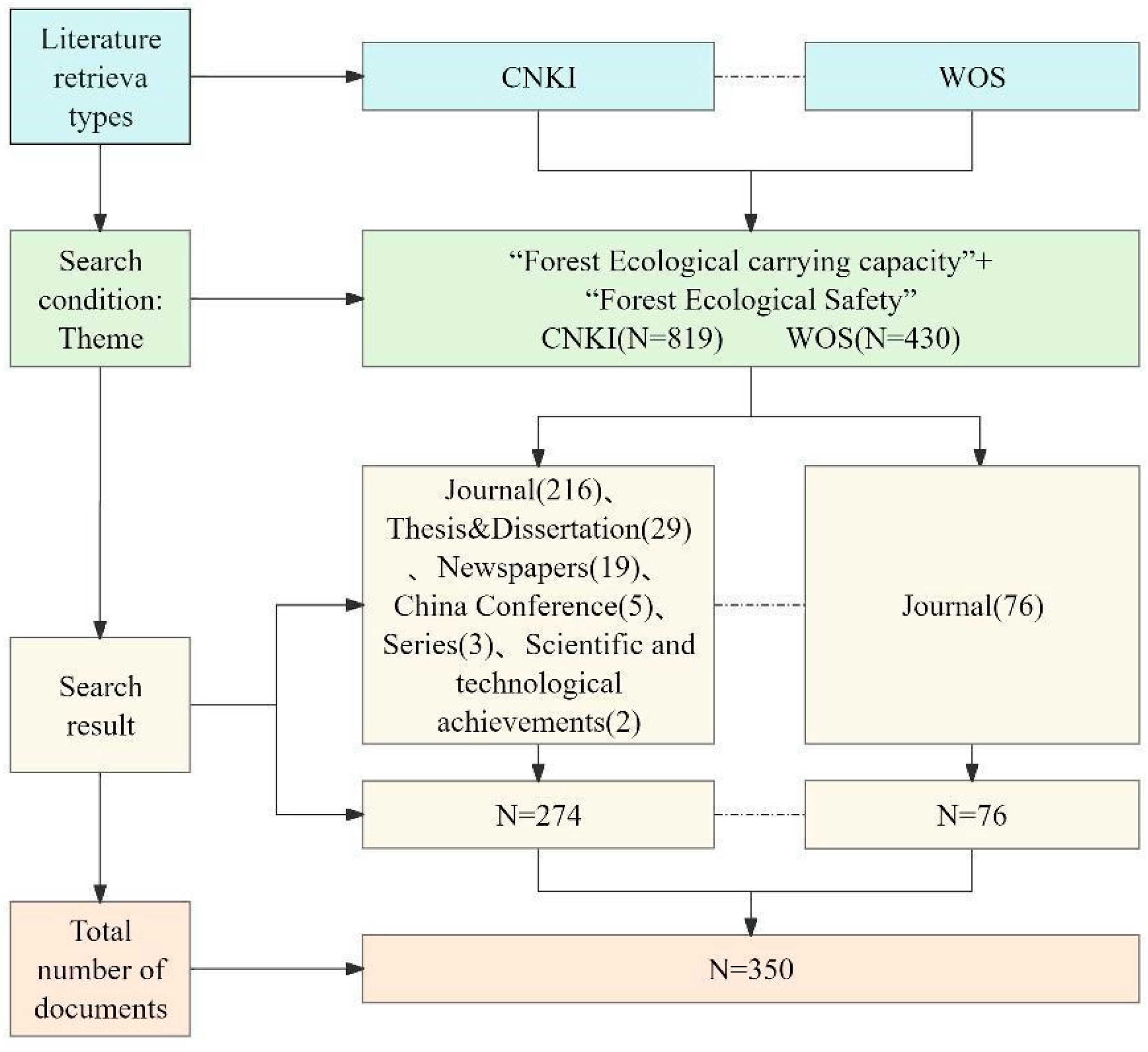
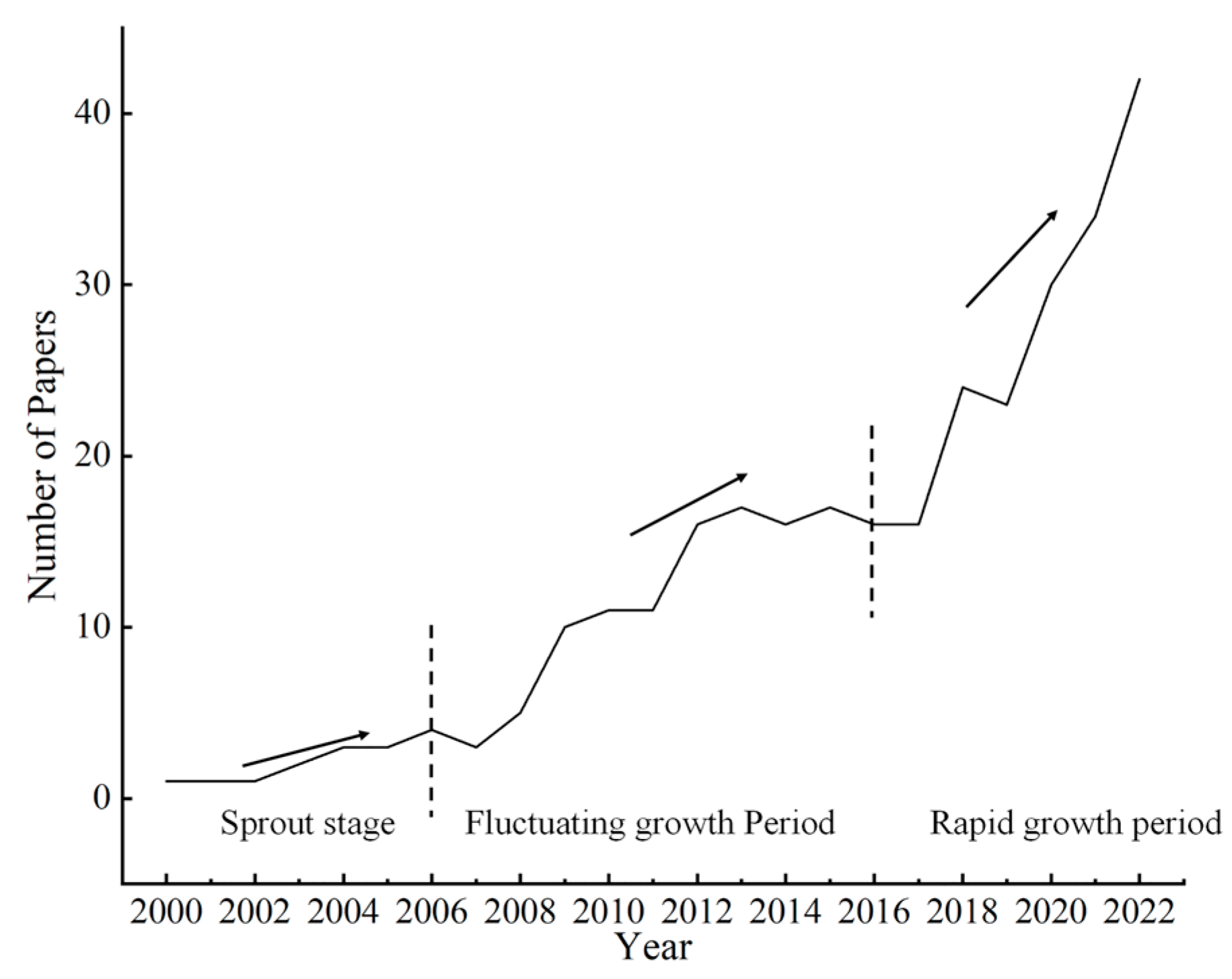

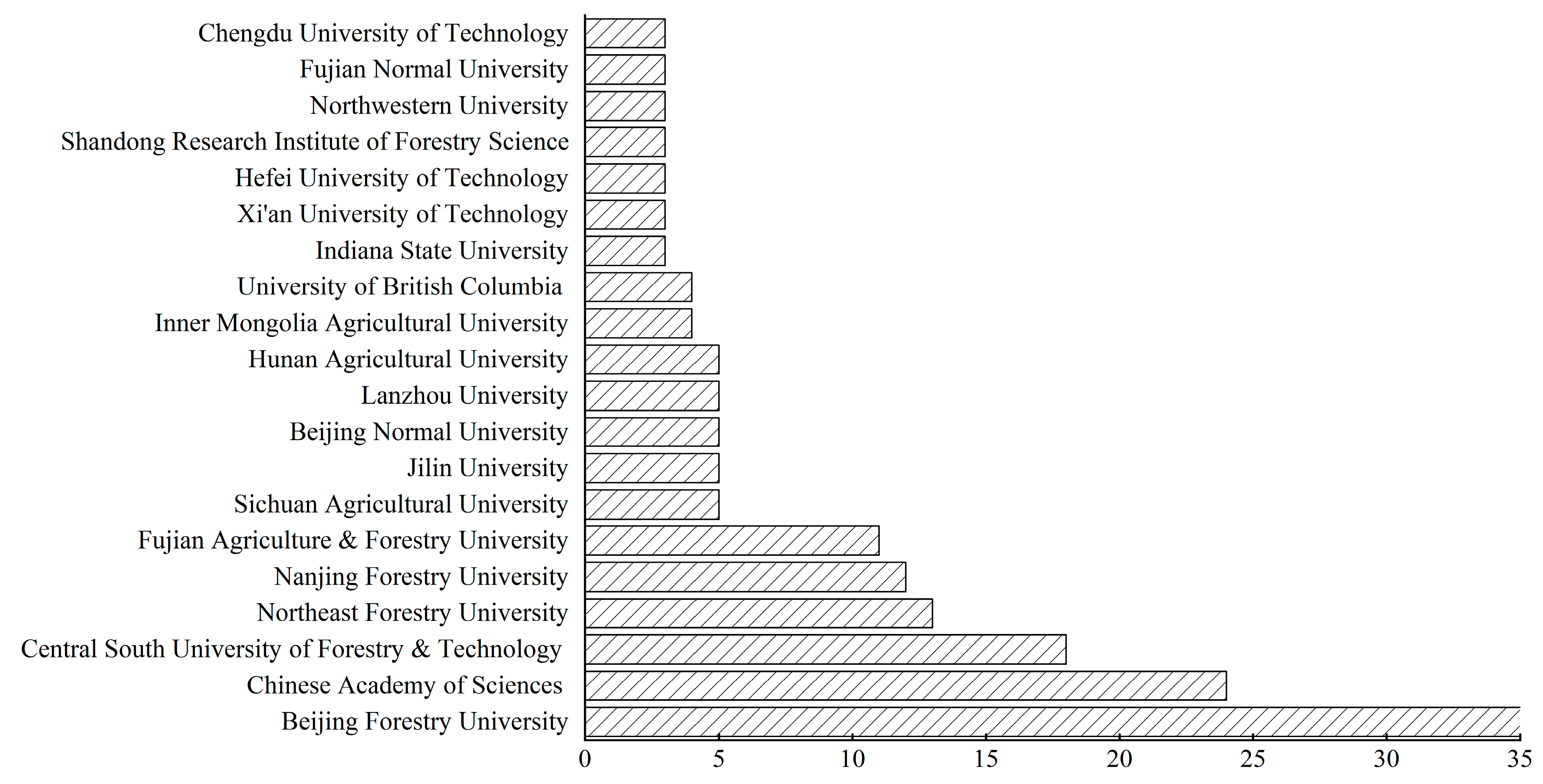
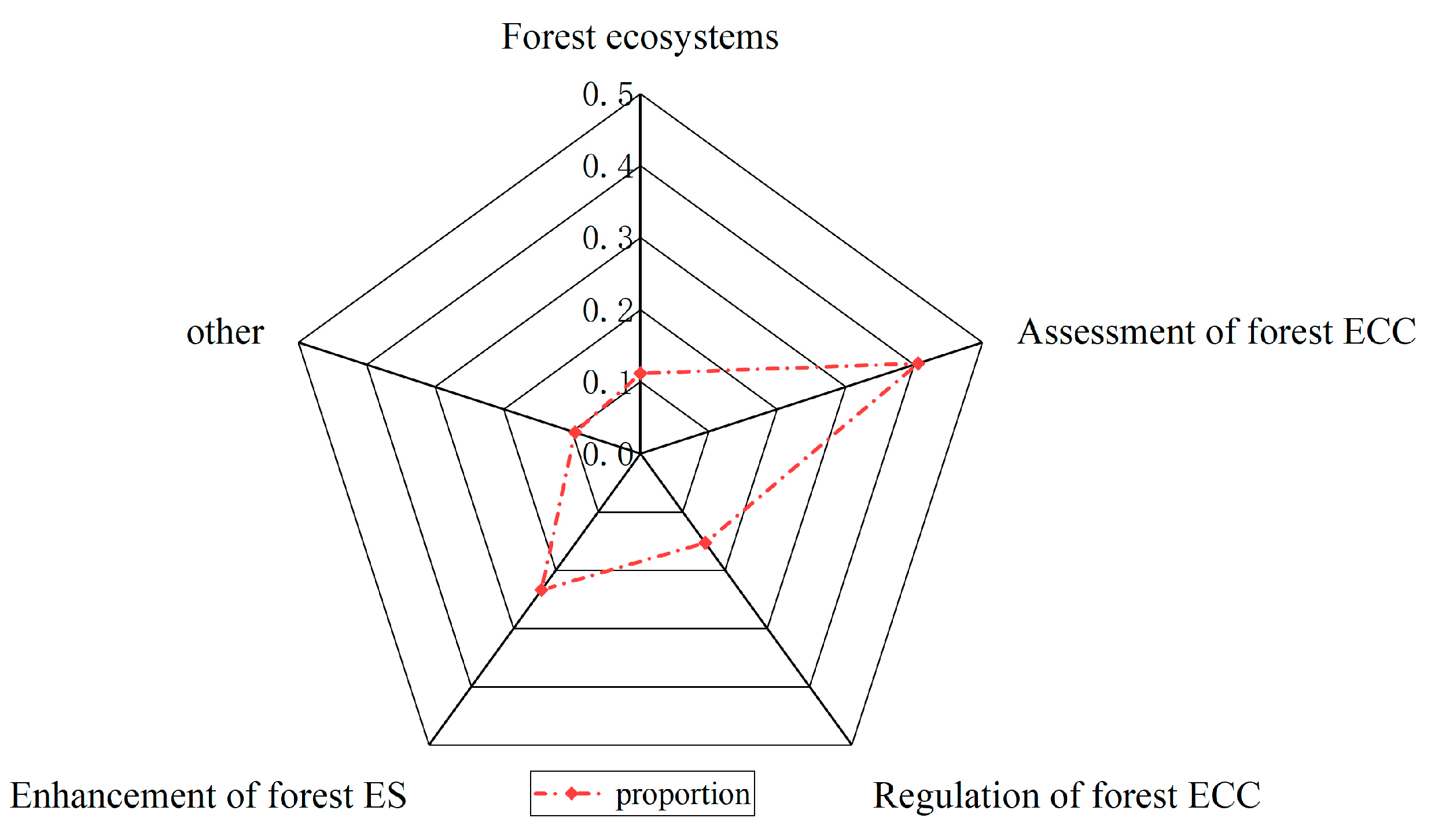
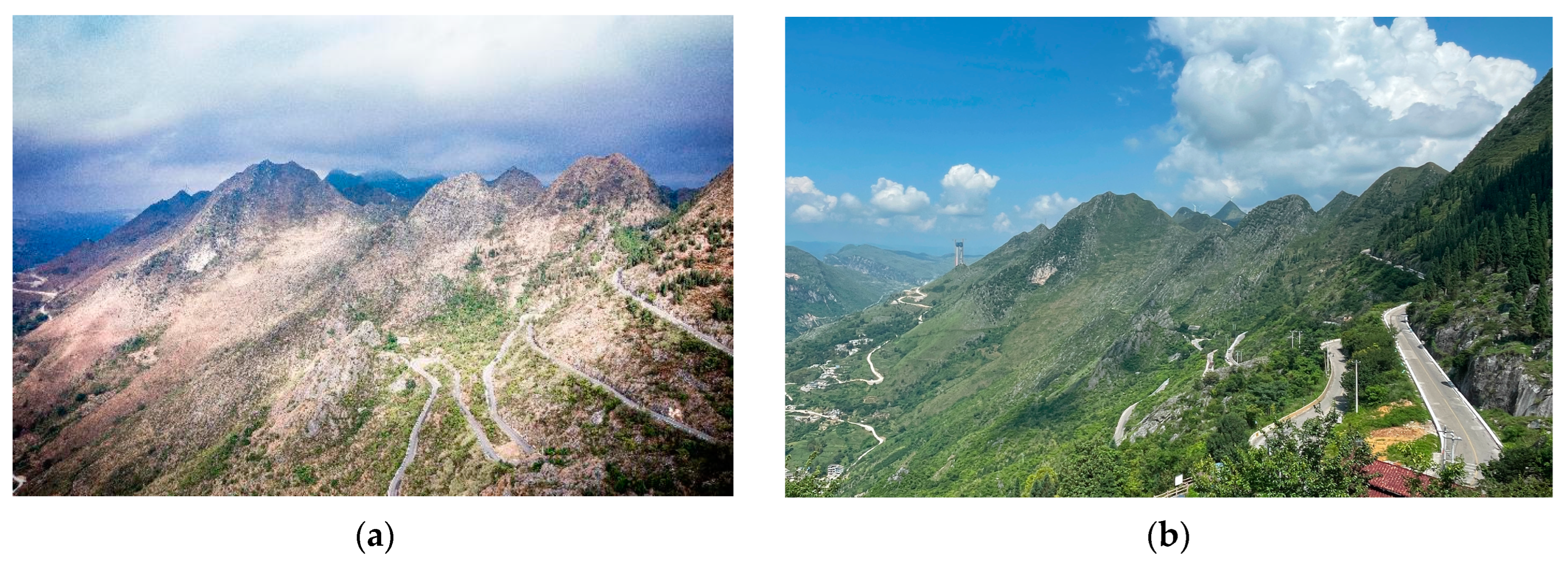

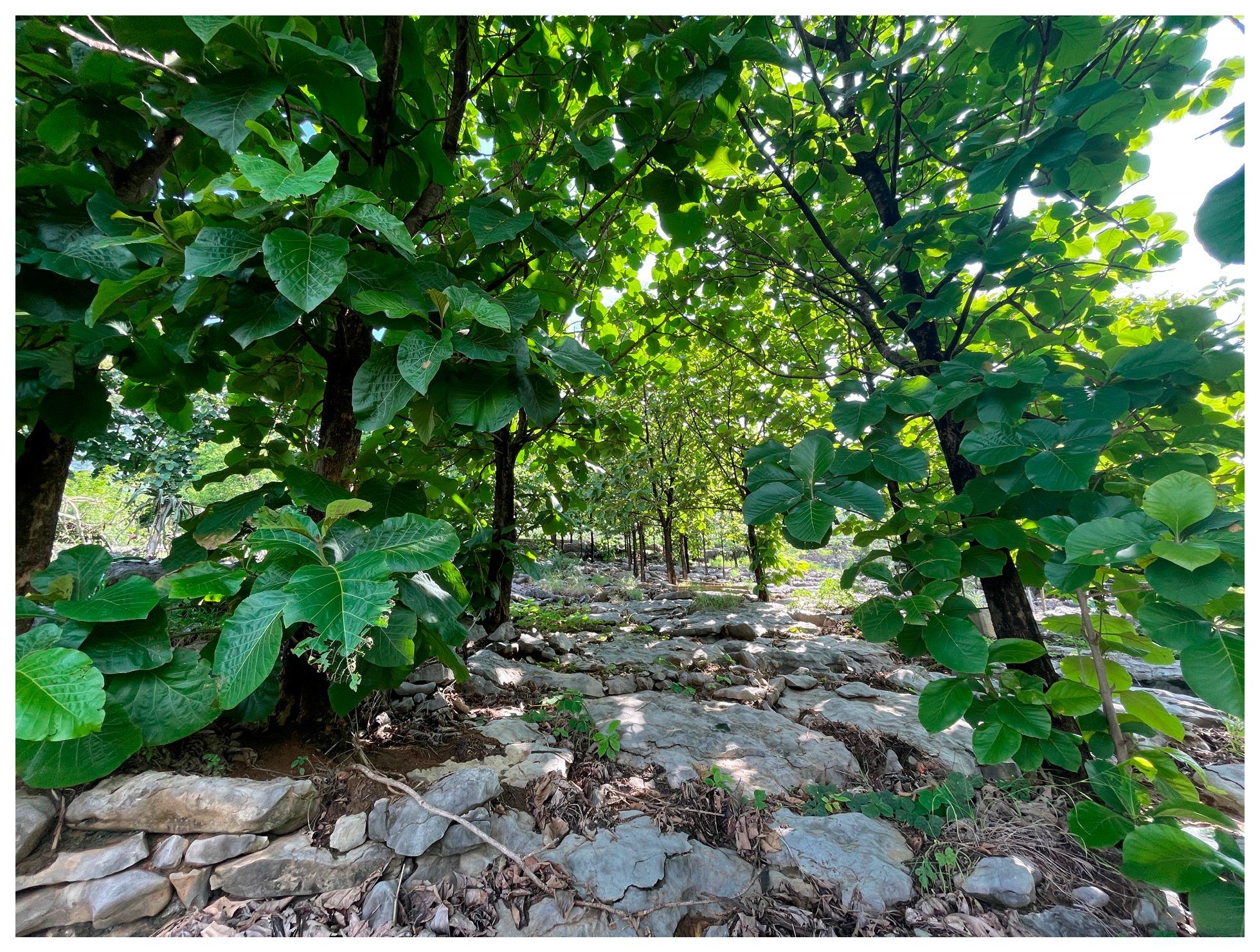


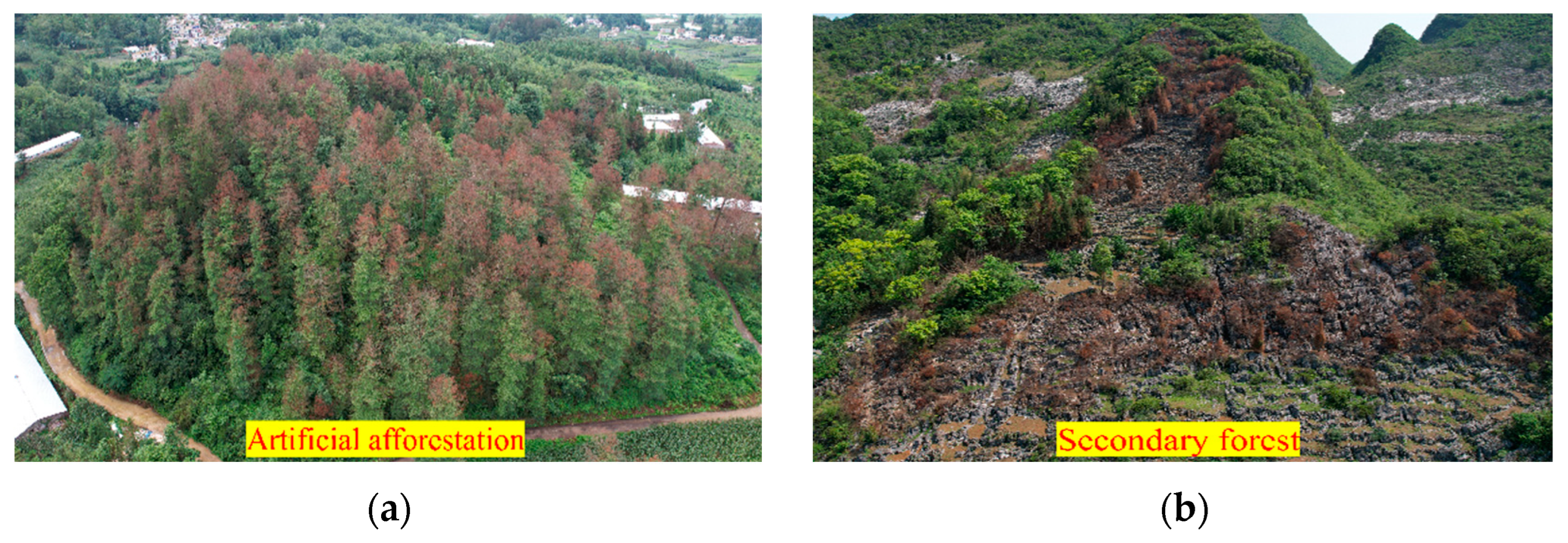



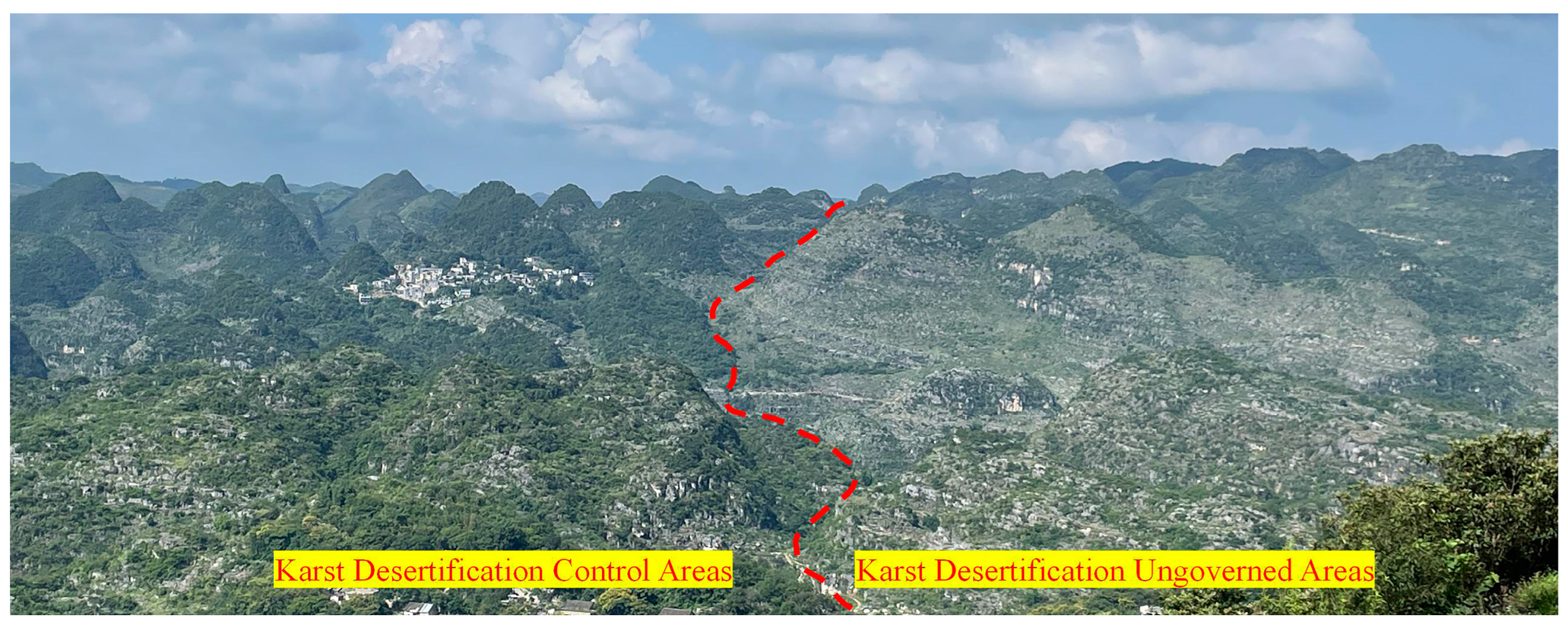
| Study Phase | Development Background | Main Features |
|---|---|---|
| Sprout stage (2000–2006) | In the 1990s, China entered the stage of sustainable development, and researchers regarded ECC as an important basis for sustainability. | The average number of related articles per year was fewer than three, suggesting a preliminary exploration of ECC and ES. The main focus was on the derivation and development of the concepts of ECC and ES, with a exploration of forest ecosystems as the research subject. |
| Fluctuating growth period (2007–2016) | In 2007, the 17th National Congress of the Communist Party of China introduced the concept of building an ecological civilization. This initiative was prompted by the increasing issues of environmental pollution, degradation of ecological quality, and inadequate ECC. As a result, ES was incorporated into the national security agenda. | The integration of ECC and ES with urban areas (clusters) and tourism expanded in research depth and scale, moving beyond natural areas. More studies focused on the ECC and ES of urban forests, forest tourism, and urban agglomerations, leading to significant developments in this field. |
| Rapid growth period (2017–2023) | The 19th National Congress of the Communist Party of China in 2017 emphasized the importance of ecological civilization as a key component of modernization and highlighted the need for an ES pattern. | The annual average number of related publications exceeded 33, with a significant increase in the literature focusing on the construction of ES patterns for forest ecosystems in various levels such as provincial, national, and national parks. |
| Method/Model | Advantages | Disadvantages | Applicable Objects | Citation |
|---|---|---|---|---|
| NPP | It can effectively demonstrate the disruption of natural systems, particularly the stability of ecosystems, and is both comprehensible and quantifiable. | It may overlook the influence of human socio-economic activities on ecosystems and the responsiveness of natural systems to ecological concerns. | This method is well suited for analyzing extensive regions like natural ecosystems and watersheds. | [42] |
| Ecological footprint model | The data acquisition methods are diverse and easily accessible, with clear theoretical foundations, relatively simple calculations, an easy verification of results, and strong adaptability. | Neglecting the functional diversity and dynamic changes in land itself hinders the ability to simulate and predict future development trends, leading to low calculation accuracy. | This method is more suitable for ecosystems in larger cities where precision requirements are lower. | [46] |
| Based on the InVEST model | Integrating ecosystem services with spatial analysis facilitates the zoning of ecosystem spatial functions. | It overlooks the influence of human economic and social activities. | This approach is more suitable for ecosystems in larger cities with lower precision. | [44] |
| Based on the AHP comprehensive evaluation method | It uses select comprehensive evaluation indicators from the perspectives of resources, environment, and socio-economic factors. | The required number of data is large, and the evaluation results are easily influenced by subjective factors. | This method is particularly suitable for researching medium- and small-scale regions with abundant data. | [45] |
Disclaimer/Publisher’s Note: The statements, opinions and data contained in all publications are solely those of the individual author(s) and contributor(s) and not of MDPI and/or the editor(s). MDPI and/or the editor(s) disclaim responsibility for any injury to people or property resulting from any ideas, methods, instructions or products referred to in the content. |
© 2024 by the authors. Licensee MDPI, Basel, Switzerland. This article is an open access article distributed under the terms and conditions of the Creative Commons Attribution (CC BY) license (https://creativecommons.org/licenses/by/4.0/).
Share and Cite
Zhang, S.; Luo, Y.; Xiong, K.; Yu, Y.; He, C.; Zhang, S.; Wang, Z. Research Progress on Ecological Carrying Capacity and Ecological Security, and Its Inspiration on the Forest Ecosystem in the Karst Desertification Control. Forests 2024, 15, 1632. https://doi.org/10.3390/f15091632
Zhang S, Luo Y, Xiong K, Yu Y, He C, Zhang S, Wang Z. Research Progress on Ecological Carrying Capacity and Ecological Security, and Its Inspiration on the Forest Ecosystem in the Karst Desertification Control. Forests. 2024; 15(9):1632. https://doi.org/10.3390/f15091632
Chicago/Turabian StyleZhang, Song, Ya Luo, Kangning Xiong, Yanghua Yu, Cheng He, Shihao Zhang, and Zhaohua Wang. 2024. "Research Progress on Ecological Carrying Capacity and Ecological Security, and Its Inspiration on the Forest Ecosystem in the Karst Desertification Control" Forests 15, no. 9: 1632. https://doi.org/10.3390/f15091632






